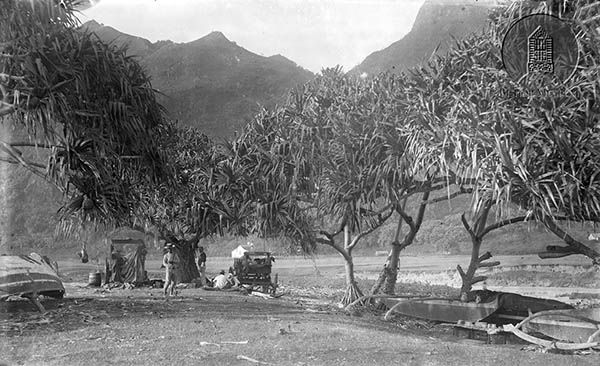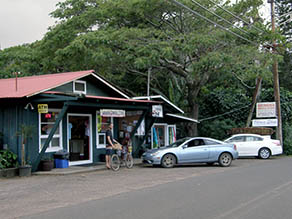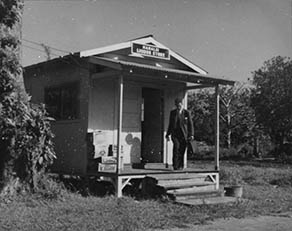 |

A hala grove near Hā‘ena, with outrigger canoes. Bishop Museum Photo.
“Nobody know the history over here, what happened,” Uncle Tom begins, “what took place at that time, in the early days, after I was born. We had Wainiha store. We used to go to the Wainiha store, the first store, the water been like that, like I told you sixteen, the water wen take 'em. And then there was another Nakatsugi store. The lady was here it was known as Nakatsugi store. I think she lived among the Hawaiians because she had seventeen acres in Kalalau. So she must have been here for quite some time, that lady, because she knew all the Hawaiians too and all the Hawaiians used to go shop over there by her store, Nakatsugi store. Same place where Wainiha store is now. The cement in front there, that’s the same stairs for go in the store, because that place it kind of slope down there like that, so it was always on stilts.

The Wainiha Store, 2017—the closest store to Hā‘ena.
“All the old time, I can picture that thing. Everything that was taking place in there. What had. Even In Hanalei. There was two Shell service stations in Hanalei. Ching Young had one, Masada had one by the school—used to get one service station there. And then Ching Maleong had one with Union Gas or something, up the road. In fact, Hanalei had four kine gas station. Sasaki had one, that turn off right over by the Catholic church. There used to be one repair shop over there.
"And that old building that’s there, the one that lives right there, the green one, by the poi mill? That was there for years. That used to be the pool room. They used to sell snacks and stuff like shochi and manapua—that place used to make them and that place still the same, that’s the same building. That building is old.

Hanalei Liquor Store, ca. 1940. Hawai‘i State Archives Photo.
“And then right on the corner where get one house right there, when you make the corner across, on this side, get that new house over there, that beige house, this guy used to have one ice cream shop over there, and used to be cement, right on that corner. And you go sit in the stool over and eat the ice cream or whatever on that corner.
"And of course they live in the main house over there, but that was their shop. They had all small kind of shops, and had my father’s store, but they sell all small stuff—candies, like that. And then they had one more other store right where the Mormon Church is, used to be Tanamura store over there. They used to sell any kind: watches and all that good stuff. And then you go up Ching Young store—there for years, that store, and it became big.

Hanalei Post Office, ca. 1950. Hawai‘i State Archives Photo.
“And they had pool room on the corner where the restaurant is. That’s a pool room, where that restaurant stay. And where Tahiti Nui is, that was another store. And then of course up where that Dolphin restaurant, it was a store too, with a service station. The first Chinese store that used to happen was way up on the black bridge—you know, when you come around that corner coming down to the head of that bridge, when you coming down the hill. You know when you come in down and then you go at a stop one that side, because get plenty cars on this side beside the bridge.
"Right that corner over there used to be the first Ching Maliong store. We used to pull out right off the side and go shop and then jump in the car and go. That place used to be one store. And all in the back there, there was a road going inside there, on this side of the river, the pasture side where the buffalo grass are, across the road. You know where that bamboo across the road, over there was all buildings before when I was young, had all buildings. All those buildings were gone, the only one in that area is the Rice mill, the one historic building going up to Hanalei, the river, the kine. That’s all historic up there and it still is a historic site.”

Unidentified house on a road in Hanalei, 1941. Hawai‘i State Archives Photo.
"You get plenty Chinese go dig all the ditches for the farm. The Chinese wen do all that, so by time we used to take and sell them the fish, they were old already. They were in their 70s maybe. Some of them had money, went back to China, but most of them died here, and so they have the Chinese graveyard up there. But they were the ones that worked hard, tend all the rice, dig all the irrigation drain.
"From Wainiha too! Used to go on up from Limahuli, used to dig water from Limahuli, ditch, and then flume by the cave, by the park, used to be one flume over there, running right across the cave, to irrigate the rice patches in front of the YMCA, in the back side. All these areas used to get all rice before. Used to be all rice farm, and they would bring water from Wainiha too, the Power Plant, Hā‘ena. Get one big ditch right on the side of the road.
“The only property owner was Kelau? and Kalei. They had two houses over here, one over there and one over here. They were the only inhabitants in this area. Most of the people moved away and these people were the last people to move out from Kalalau—The valley of the Lost Tribe. They were Kalalau people. They moved out there in the late 1800’s I guess. So they became my family, like Hanohano’s sister was my Grandma.”

Japanese farmer's grass house near Hanalei, Kauai. ca. 1910. Hawai‘i State Archives Photo.
“I grew up without McDonalds,” Michael tells us. “I grew up with kerosene stove. My mom used to cook with kerosene. No hot water heater; you boil your hot water in a five-gallon cracker can, and then you bathe. If you wanted hot water, you got to go make your own.
“We had one doctor office, Dr. Ishii. He was working out of Hanalei. And every time you got sick, all he did was poke you with a needle. That’s why I hate needles. They come up, ‘Oh, you got a cold, flu, whatever.’ He loved the needle. Dr. Ishii, yeah, it was there by the old Court House, and right across the park in Hanalei, a small little office.
“Grocery store, had the one in Hanalei, the old Ching Young, and Ching Maleong, where the Dolphin Restaurant is. We had the small store in Wainiha—Nakatsuji Store used to be. It closed in ‘69, my senior year in high school when gas was 37 cents a gallon. There was a gas pump there. The tank held 300 gallons, they had to bring them by 55-gallon drum , gravity flow they fed the tank. But 37 cents a gallon is a good price! Fill them up on Sunday and drive all week. I opened that back in ‘75. My second-oldest son and my older daughter run that place now.

Undated photo of road in Hanalei, probably where the bridge over the river is now. Hawai‘i State Archives Photo.
“We grew up in a time where life was really simple,” Nalani states, “really simple. It was a really good life, even if at the time we’re thinking, ‘God, we got to work so hard!’ I’m really glad that my grandparents worked us, because now we can survive in today’s world. We must get to go and work, we must to get our hands dirty in the mud. I try to tell the young kids, and they say ‘Oh no, I don’t want to get dirty.’ There is nothing wrong with getting dirty, but if you want to be all Mr. Clean or Mrs. Clean, you’re not going to survive. You got to get your hands dirty. But a lot of the kids nowadays, no, they want to be all slick. Same way with their clothes, they want to be all dressed and made up. Okay, well when you’re not going to have your food source, what good is that going to do you? You’d better be thinking again.” |
 |



























